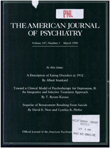The epidemiology of dysthymia in five communities: rates, risks, comorbidity, and treatment
Abstract
Data from a survey of five U.S. communities showed that dysthymia affected approximately 3% of the adult population. It was more common in women under age 65, unmarried persons, and young persons with low income and was associated with greater use of general health and psychiatric services and psychotropic drugs. Dysthymia had a high comorbidity with other psychiatric disorders, particularly major depression; only about 25%-30% of cases occur over a lifetime in the absence of other psychiatric disorders. The findings suggest that although the onset and highest risk periods of major depression and bipolar disorder are in young adulthood, a residual state of dysthymia occurs in middle and old age.
Access content
To read the fulltext, please use one of the options below to sign in or purchase access.- Personal login
- Institutional Login
- Sign in via OpenAthens
- Register for access
-
Please login/register if you wish to pair your device and check access availability.
Not a subscriber?
PsychiatryOnline subscription options offer access to the DSM-5 library, books, journals, CME, and patient resources. This all-in-one virtual library provides psychiatrists and mental health professionals with key resources for diagnosis, treatment, research, and professional development.
Need more help? PsychiatryOnline Customer Service may be reached by emailing [email protected] or by calling 800-368-5777 (in the U.S.) or 703-907-7322 (outside the U.S.).



